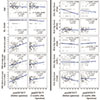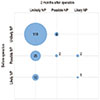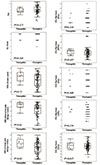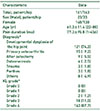Abstract
Purpose
Pain caused by osteoarthritis is primarily nociceptive pain; however, it is considered that a component of this pain is due to neuropathic pain (NP). We investigated the effects of total hip arthroplasty (THA) in patients with NP diagnosed by the PainDETECT questionnaire.
Materials and Methods
One hundred sixty-three hips (161 patients) were evaluated. All patients were asked to complete the PainDETECT questionnaire based on their experience with NP, and clinical scores were evaluated using the Japanese Orthopaedic Association (JOA) Hip Score before and after THA.
Results
The patients of 24.5% reported NP before THA; 5.5% reported NP 2 months after THA. Prior to THA, there was no significant correlation between the PainDETECT score and the radiographic severity; however, there was a significant correlation between the PainDETECT score and JOA score. NP at 2 months after THA was not significantly correlated with pain scores at 1 week after THA; however, a significant correlation was observed between the preoperative pain score and NP at 2 months after THA.
Osteoarthritis, which refers to a clinical syndrome of joint pain accompanied by various degrees of functional limitation and reduced quality of life, is a major cause of pain and disability that affects patients' quality of life and activities of daily living. It is the most common musculoskeletal disorder1).
Pain is classified into two types: nociceptive pain and neuropathic pain (NP). Nociceptive pain, such as the pain associated with osteoarthritis, results from the continuous stimulation of nociceptors caused by chronic inflammation. NP is generated by either damage to, or dysfunction of, the nervous system23). There have been several reports of NP in osteoarthritis4); three described the relationship between osteoarthritis-related pain and the prevalence of NP diagnosed by the PainDETECT (PD)5) in patients with osteoarthritis of the knee or hip joint. Pain with an NP component was reported in 18.5% to 34% of patients with osteoarthritis of the knee or hip joint678).
Total hip arthroplasty (THA) has been used to relieve hip pain and improve hip function in many patients since it was first introduced by Sir John Charnley9). Of note, there have been no reports on the effects of THA in patients with NP. Therefore, this study aimed to investigate the effects of THA in patients with NP diagnosed based on the PD score.
The study protocol adhered to the ethical guidelines of the 1975 Declaration of Helsinki, and the study was approved by the institutional review board of our institution (approval number, 2016-09-09). All patients provided written informed consent before participating in this study. Between April 2007 and December 2007, we performed 354 consecutive cementless THA procedures in our hospital. We excluded 52 hips (49 patients) in which THA with subtrochanteric osteotomy10) or revision THA was performed. The remaining 302 hips (284 patients) were included in this study. Finally, 163 hips (161 patients; men [n=23], women [n=140]) who completed the questionnaire were enrolled in the study (Fig. 1). The mean age at the time of THA was 61.3 years, and the cause of hip joint pain was developmental dysplasia of the hip joint in 74.2% of patients. All hips were classified as Kellgren-Lawrence (KL) grade11) 2, 3, or 4 according to radiographic findings. No hips were classified as KL grades 0 or 1. In 92.6% of the cases, osteoarthritis of the hip joint was the principal disease that led to surgery (Table 1).
All operations were performed under spinal anesthesia. Flurbiprofen axetil, diclofenac sodium, pentazocine, and loxoprofen sodium were used at the attending physician's discretion. Patients were allowed to stand and walk with full weight bearing 2 days postoperatively.
Hips were evaluated preoperatively using the Japanese Orthopaedic Association (JOA) Hip Score10). The JOA score covers four categories using a 100-point scale: pain (40 points), range of motion (20 points), walking ability (20 points), and activities of daily living (20 points). The patients were asked to complete the PD questionnaire based on their self-assessment of NP. The PD5) was developed as a self-administered psychometric questionnaire to distinguish NP from non-NP among people with chronic low back pain. It is comprised of three components that evaluate: i) pain quality (n=7 components), ii) pain pattern (n=1 component), and iii) pain radiation (n=1 component), which all contribute to an aggregate score (range, −1 to 38). The PD has been validated against expert physicians' diagnoses of NP in people with various chronic pain conditions, including typical NP or typical non-NP conditions. Its overall sensitivity, specificity, and positive predictive values using a cut-off score of 19 (NP symptoms ≥19), are 85%, 80%, and 83%, respectively. The numerical rating scale (NRS) was used to evaluate pain at three time points in all patients: i) pain at the entry point, ii) the most severe pain during the subsequent 4 weeks, and iii) average pain during the 4 weeks. Patients were divided into three groups based on the total score: i) ≥19 (NP was likely), ii) 13 to 18 (NP was possible), iii) ≤12 (NP was unlikely). The PD was used to evaluate NP before and at 2 months after THA.
At 2 months postoperatively, all subjects were divided into two groups; the nociceptive pain group and the NP group. The NP group included patients with likely and possible NP.
Numerical data are expressed as the mean±standard deviation. Statistical analyses were conducted using SPSS for Windows (version 22; IBM Corp., Armonk, NY, USA). The Student t-test, paired t-test, χ2 test, and Pearson's product moment test were used as appropriate. The P-values less than 0.05 were considered to indicate statistical significance.
Significant differences were observed in the numerical rating scale score for pain at the entry point, the most severe pain during the past 4 weeks, and average pain during the past 4 weeks between before THA and 2 months after THA (all P<0.01, Fig. 2). Based on the PD scores, possible or likely NP was detected in 24.5% of the patients before THA and in 5.5% of the patients at 2 months after THA (P<0.01). Zero hips classified as KL grade 3 and 11 hips classified as KL grade 4 had likely NP before THA, whereas 1 hip classified as KL grade 3 and 2 hips classified as KL grade 4 had likely NP at 2 months after THA. Before THA, significant associations were observed between the PD score and all pain scores (all P<0.01, Fig. 3). Significant associations were observed between the PD score at 2 months after THA and all pain scores before THA, with the exception of the pain item in the JOA score before THA (all P<0.01, Fig. 3). Among the hips with possible or likely NP at 2 months after THA (n=9), 4 had unlikely NP before THA, 4 had possible NP before THA, and 1 hip had likely NP before THA. None of the hips showed deterioration from unlikely NP before THA to likely NP at 2 months after THA (Fig. 4). There was no significant difference in the pain score at the entry point at 1 week after THA between the patients with and without NP at 2 months after THA. Among the patients with NP (NP group [n=9]; men [n=2], women [n=7]) and without NP (nociceptive pain group [n=154]; men [n=21], women [n=133]) at 2 months after THA, all pain scores according to the PD showed significant differences compared to the scores before THA (entry point, P<0.05; most severe pain during 4 weeks, P<0.01; and average pain during 4 weeks, P<0.01; Fig. 5).
Osteoarthritis, the most common musculoskeletal disorder, leads to various clinical syndromes, including joint pain accompanied by varying degrees of functional limitation, which affects patient's quality of life. In addition to affecting at least 50% of the elderly population, osteoarthritis can affect younger individuals1).
Osteoarthritic-related pain is believed to be nociceptive pain caused by joint inflammation. This inflammation causes sensitization of the peripheral nerve terminals, leading to changes in joint nociceptors and the activation of nociceptive processing in the spinal cord, brain stem, and thalamocortical system12). However, several studies have suggested the existence of a neuropathic component in osteoarthritis pain4). A decrease in the amount of joint fluid and the destruction of the osteochondral junction may induce injury to the nerve endings in this area in the late stage of osteoarthritis8).
The mechanism by which NP develops in osteoarthritis is inferred based on the two following hypotheses. First, the nerve innervating the subchondral bone is damaged because of the weight-bearing surface in the late stage of osteoarthritis, or because the synovium produces joint fluid-which stimulates the free nerve endings in the synovium. Second, a decrease in the amount of joint fluid and destruction of the osteochondral junction may induce injury to the nerve endings in this area in the late stage of osteoarthritis8). It has been observed that NP is more severe than nociceptive pain, and it disturbs patients' quality of life to a greater extent13). Furthermore, NP often shows a chronic course and tends to be difficult to cure because it is correlated with central sensitization14). Among patients with shoulder impingement syndrome, those with high preoperative levels of central sensitization-often induced by NP-showed poor postoperative outcomes15).
In a previous report using the PD questionnaire, 23% of patients with osteoarthritis of the hip joint were found to have NP7), compared with 21% to 28% of patients with osteoarthritis of the knee joint6814). Herein, NP was detected in 24.5% of the patients with osteoarthritis of the hip joint, and NP measured by the PD questionnaire tended to be more severe than nociceptive pain, which is in line with findings of previous reports78). There was no significant correlation between the PD score and severity of osteoarthritis on radiographs in patients with osteoarthritis of the hip joint, which is again in line with the results of a previous study. Osteoarthritis-related pain is complex, as it is affected by local factors and activation of the central pain-processing pathway16); thus, it is not always possible to evaluate osteoarthritis based on the severity of radiographic findings alone.
To the best of our knowledge, this is the first study to investigate changes in the PD score between before and after THA. So-called chronic post-surgical pain (CPSP) or severe persistent post-surgical pain (PPP) is considered to be an inevitable surgical complication17); CPSP was reported to affect 12% of patients who underwent THA in a previous study18). The risk factors for CPSP and PPP include preoperative and postoperative severe pain17). In our study, there was a significant difference in pain scores before THA between the nociceptive pain and NP groups. However, in the pain scores at 1 week after THA, no significant differences were observed between the nociceptive pain and NP groups at 2 months after THA. We believe that the PD score and postoperative pain scores were not significantly different because the severity of pain at 1 week after THA was significantly lower than that before THA. The incidence of CPSP or PPP is lower in patients undergoing THA than in those undergoing other operations17). Even so, the results suggest that pain control before THA is important for preventing postoperative PD.
There are some guidelines concerning the pharmacological management of NP192021). In these guidelines, pregabalin and gabapentin are recommended as first-line drugs. When treatment for nociceptive pain is unsuccessful, treatment for NP should be considered, even in patients with osteoarthritis of the hip joint, where the pain is believed to be largely nociceptive in nature.
The present study has several limitations. First, the follow-up period in the current study (2 months postoperatively) does not conform to the criteria for assessing CPSP or PPP, according to which “the pain should be of at least 3 to 6 months' duration and significantly affect the quality of life”22). Second, the PD was developed as a self-administered psychometric questionnaire to distinguish NP from non-NP among people with chronic low back pain5); thus, its suitability for assessing other forms of pain has not been validated. Third, the NP examined in this study did not exclude the NP originating from other diseases (e.g., spinal diseases or metabolic diseases). Further studies are therefore needed to validate the use of the PD for pain assessment in patients with osteoarthritis.
The PD identified NP in 24.5% (likely and possible NP) of our patients with osteoarthritis of the hip joint before THA. After THA, the proportion of patients with NP significantly decreased to 5.5%. This indicates that THA is useful for relieving nociceptive pain and for relieving NP in patients with hip osteoarthritis. A “high” preoperative pain score was a risk factor for NP after THA. Thus, controlling preoperative pain may be effective at reducing postoperative NP. Obtaining a deeper understanding of the existence of NP is important for treating osteoarthritis of the hip joint.
Figures and Tables
 | Fig. 2Pain scores of study participants. The error bars indicate standard deviations.NRS: numerical rating scale.
|
 | Fig. 3The relationship between the PainDETECT scores before or 2 months postoperatively and the factors preoperatively.KL: Kellgren-Lawrence, NRS: numerical rating scale, JOA: Japanese Orthopaedic Association, ROM: range of motion, ADL: activities of daily living.
|
 | Fig. 4Patient factors before total hip arthroplasty (THA) in the neuropathic and nociceptive pain groups at 2 months after THA.NP: neuropathic pain.
|
 | Fig. 5The patient factors before total hip arthroplasty (THA) in the nociceptive and neuropathic pain group at 2 months after THA.KL: Kellgren-Lawrence, NRS: numerical rating scale, JOA: Japanese Orthopaedic Association, ROM: range of motion, ADL: activities of daily living.
|
Table 1
Patients' Characteristics

ACKNOWLEDGEMENTS
The authors thank Mr. Takao Inoue and Ms. Hitomi Ono for their contributions to this study.
References
1. Sharma L, Kapoor D, Issa S. Epidemiology of osteoarthritis: an update. Curr Opin Rheumatol. 2006; 18:147–156.

2. Jensen MP, Dworkin RH, Gammaitoni AR, Olaleye DO, Oleka N, Galer BS. Assessment of pain quality in chronic neuropathic and nociceptive pain clinical trials with the neuropathic pain scale. J Pain. 2005; 6:98–106.

3. Siddall PJ, McClelland JM, Rutkowski SB, Cousins MJ. A longitudinal study of the prevalence and characteristics of pain in the first 5 years following spinal cord injury. Pain. 2003; 103:249–257.

4. Dimitroulas T, Duarte RV, Behura A, Kitas GD, Raphael JH. Neuropathic pain in osteoarthritis: a review of pathophysiological mechanisms and implications for treatment. Semin Arthritis Rheum. 2014; 44:145–154.

5. Freynhagen R, Baron R, Gockel U, Tölle TR. painDETECT: a new screening questionnaire to identify neuropathic components in patients with back pain. Curr Med Res Opin. 2006; 22:1911–1920.

6. Hochman JR, French MR, Bermingham SL, Hawker GA. The nerve of osteoarthritis pain. Arthritis Care Res (Hoboken). 2010; 62:1019–1023.

7. Shigemura T, Ohtori S, Kishida S, et al. Neuropathic pain in patients with osteoarthritis of hip joint. Eur Orhtop Traumatol. 2011; 2:73.

8. Ohtori S, Orita S, Yamashita M, et al. Existence of a neuropathic pain component in patients with osteoarthritis of the knee. Yonsei Med J. 2012; 53:801–805.

10. Sonohata M, Tajima T, Kitajima M, et al. Total hip arthroplasty combined with double-chevron subtrochanteric osteotomy. J Orthop Sci. 2012; 17:382–389.

11. Kellgren JH, Lawrence JS. Radiological assessment of osteo-arthrosis. Ann Rheum Dis. 1957; 16:494–502.

12. Schaible HG. Mechanisms of chronic pain in osteoarthritis. Curr Rheumatol Rep. 2012; 14:549–556.

13. Bouhassira D, Lantéri-Minet M, Attal N, Laurent B, Touboul C. Prevalence of chronic pain with neuropathic characteristics in the general population. Pain. 2008; 136:380–387.

14. Hochman JR, Davis AM, Elkayam J, Gagliese L, Hawker GA. Neuropathic pain symptoms on the modified painDETECT correlate with signs of central sensitization in knee osteoarthritis. Osteoarthritis Cartilage. 2013; 21:1236–1242.

15. Gwilym SE, Oag HC, Tracey I, Carr AJ. Evidence that central sensitisation is present in patients with shoulder impingement syndrome and influences the outcome after surgery. J Bone Joint Surg Br. 2011; 93:498–502.

16. Sofat N, Ejindu V, Kiely P. What makes osteoarthritis painful? The evidence for local and central pain processing. Rheumatology (Oxford). 2011; 50:2157–2165.

17. Tawfic Q, Kumar K, Pirani Z, Armstrong K. Prevention of chronic post-surgical pain: the importance of early identification of risk factors. J Anesth. 2017; 31:424–431.

19. Dworkin RH, O'Connor AB, Backonja M, et al. Pharmacologic management of neuropathic pain: evidence-based recommendations. Pain. 2007; 132:237–251.

20. Attal N, Cruccu G, Baron R, et al. EFNS guidelines on the pharmacological treatment of neuropathic pain: 2010 revision. Eur J Neurol. 2010; 17:1113–e88.





 PDF
PDF ePub
ePub Citation
Citation Print
Print




 XML Download
XML Download